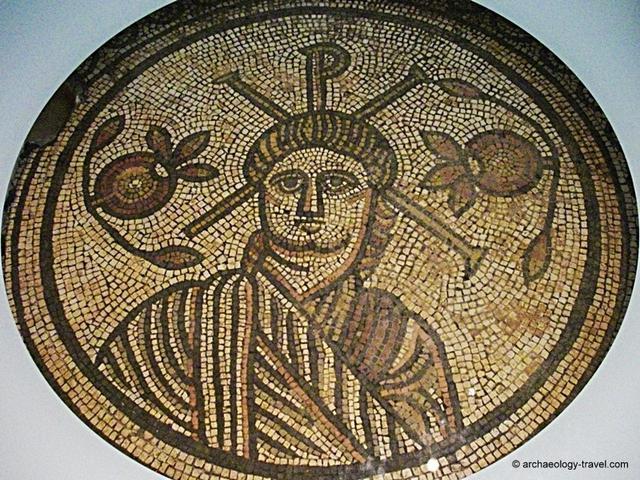Mosaic of Christ

The Mosaic of Christ is a remarkable piece of ancient art that offers a fascinating glimpse into the early days of Christianity in Britain. Discovered in a Roman villa in Dorset, England, this portrait is believed to be one of the oldest representations of Christ. The image depicts a blonde, shaven man dressed in a tunic and cloak, with the Greek letters chi (X) and rho (P) behind his head, forming the word Christos. This mosaic is part of a larger artwork that also includes pagan elements, such as the depiction of the Greek hero Bellerophon riding Pegasus and slaying the monstrous chimera.
The significance of this mosaic lies in its historical context. In 312 AD, Emperor Constantine's conversion to Christianity marked a turning point for the religion, allowing it to spread freely throughout the Roman Empire. At that time, Britain was a remote province that would eventually be abandoned by the empire. The Mosaic of Christ may have adorned the dining room of a villa or a church owned by one of the British Roman aristocratic families, reflecting the blending of Christian and pagan imagery that was common during this period.
The juxtaposition of Christ with the mythological figure of Bellerophon slaying the chimera is particularly intriguing. Some scholars suggest that this scene symbolizes Christ's triumph over death and evil, highlighting the transformative power of Christianity. The mosaic serves as a visual representation of the cultural and religious diversity that characterized the Roman Empire, showcasing the syncretism of beliefs and traditions that shaped the ancient world.
Visitors to the museum where the Mosaic of Christ is displayed can marvel at the intricate details of this ancient artwork and contemplate its historical significance. As they gaze upon the serene face of Christ and the heroic figure of Bellerophon, they are transported back in time to a period of transition and transformation. The mosaic invites viewers to ponder the complexities of faith, art, and identity in the ancient world, offering a window into the rich tapestry of beliefs that shaped the Roman Empire and beyond.
© ChatGPT 3.5